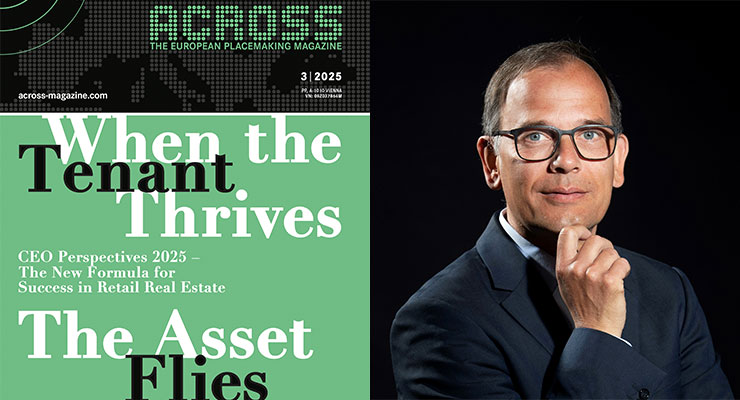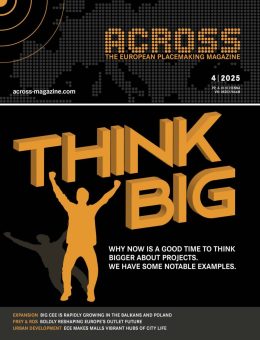The CEOs and top managers featured in this cover story come from diverse markets, business models, and company sizes – from international outlet and shopping center operators to property developers, technology providers, and specialized experts in retail design and lighting. Despite this variety, clear common themes emerge. Their responses were unanimous: the future of retail real estate will no longer be measured in square meters or pure footfall, but in the shared ability of owners and tenants to create relevance, inspire customers, and operate sustainably.
Six key points stood out in particular:
1. Professionalizing partnerships: Moving beyond short-term lease optimization towards joint business planning and continuous, level-based dialogue.
2. Tenant success as a KPI: Integrating performance metrics such as sales, customer loyalty, and brand development into asset strategy.
3. Creating experience and meaning: Centers must serve as societal, emotional, and functional anchors – not merely retail spaces.
4. Thinking digital, executing physical: Using digital tools deliberately to drive revenue and efficiency, serving both landlord and tenant interests.
5. ESG as a business case: Harnessing sustainability to attract investors, tenants, and consumers while proactively meeting regulatory demands.
6. Flexibility as a resilience factor: Building structural and functional adaptability into both new and existing assets to minimize market risks.
Together with Klaus Striebich, Managing Director of RaRE Advise and Head of the ACROSS Advisory Board, we explored these themes and asked how far they are being put into practice.
1. PROFESSIONALIZING PARTNERSHIPS
Partnerships are no longer transactional –they’re transformational,” says Cindy Andersen, Managing Director at Ingka Centres. Her statement captures the thread running through the reflections of leading retail real estate figures: the future no longer belongs to the traditional landlord-tenant relationship, but to strategic partnerships.
Klaus Striebich adds, for him, partnership is not a single deal or contract but an interplay on multiple levels, from information exchange to close cooperation, joint projects, and even equity participation. “A landlord is not merely a provider of space, but a co-responsible party for the success achieved within that space.” Genuine partnership, Striebich stresses, means standing together even in difficult times and actively nurturing the relationship.

Klaus Striebich
Klaus Striebich is Managing Director of RaRE Advise and Head of the ACROSS Advisory Board
2. TENANT SUCCESS AS A KPI
Almost all industry leaders agree: seeing tenants merely as space takers is far too shortsighted. What matters is the joint journey – whether through turnover rents, co-creating new concepts, or shared marketing. “When a tenant thrives, the center immediately benefits,” says Giles Membrey of Rioja Estates. Landlords are evolving into “performance partners,” actively contributing to their tenants’ business success.
Striebich shares this view: for him, relevance is not just about short-term revenue, but about building customers’ emotional attachment to the brand and the location. “Experience per square meter instead of turnover per square meter” is the new benchmark. Customers don’t have to buy something with every visit – what matters is that they enjoy a positive experience, fostering long-term loyalty across channels. The key lies in an omnichannel approach, connecting online and offline.
3. FROM SQUARE METERS TO RELEVANCE – EXPERIENCE OUTWEIGHS SPACE
Future-proof retail is less about space and more about meaning,” stresses Pınar Yalcınkaya of MPC Properties. Sales area alone is no longer enough. What is needed is relevance – for visitors, communities, and cities alike. From food halls and educational programs to cultural events, retail properties are evolving into multifunctional destinations where people work, learn, eat, play, and connect. “If a place touches the heart, people return – and tenants succeed,” says Thomas Mark of MK Illumination. Emotional experiences have become the most critical differentiator. Whether through immersive lighting installations, food plazas, or interactive events – anything that inspires excitement increases dwell time and strengthens loyalty. Where people enjoy spending time, everyone benefits: tenants, operators, and the overall location brand.
Striebich confirms this perspective: customers cannot constantly be expected to spend – sometimes it’s simply about enjoying their stay. This emotional dimension is decisive because it influences future purchasing decisions. Those who collect positive experiences during visits are more likely to buy later, whether online or offline. Experience is becoming the central driver of relevance.
4. DATA AS A SHARED CURRENCY
“Space alone is not the product,” says Susan Hagerty Bonsak of Placewise. It is only with digital infrastructure, loyalty programs, and shared data analysis that a property becomes future-proof. More and more operators are sharing sales and visitor data with tenants – not as a control mechanism, but as the basis for better decision-making.
Striebich highlights the importance of this mindset shift: while opacity was once considered an advantage, today only transparency enables progress. Sales figures, customer flows, and omnichannel effects such as the “halo effect” must be shared and jointly harnessed. “What matters is that data are not used for control but for value creation,” he explains. Information must be turned into utility – only then can genuine partnership emerge.
5. ESG AS A BUSINESS CASE
Sustainability is long past being a PR topic. “Flexibility is a form of sustainability,” notes Rowan Verwoerd of Redevco. Operators are investing in solar installations, circular construction, and flexible structures to reap both ecological and economic benefits. NEPI Rockcastle, for example, is heavily investing in solar power, generating energy not only for its centers but also for its tenants – a move that is both ecological and economical. “We are on the way to becoming the largest non-energy producer of renewable energy in CEE,” says CEO Rüdiger Dany.
Striebich draws distinctions: he differentiates between regulatory requirements and customer influence. Even though political requirements have recently been weakened, consumers and economic advantages continue to drive the issue. Those who implement energy efficiency, CO₂ savings, and circular materials reduce costs and win greater acceptance among customers. Research and innovation, such as alternative building materials, are opening new doors. “Only if ecological and economic interests can be aligned will ESG succeed eventually.”
6. FLEXIBILITY AND MIXED USE
Mixed-use, flexible floor plans, and new spatial concepts – the industry is discovering flexibility as a key factor. Properties that can easily adapt are not only more sustainable, but also more resilient to market changes. This gives rise to urban districts that combine retail with gastronomy, leisure, offices, or housing. The shopping center of the future will thus be less of a monoculture and more of a multifunctional building block of the city.
Striebich cautions, however, that the very word “immobilia” means immovable – therefore, flexibility must be planned from the outset. Buildings should be designed to allow conversion to other uses in the future. “Think of tomorrow’s reletting when signing today’s lease,” is his credo. Too many projects are still developed too narrowly and monofunctionally because this is initially cheaper. Yet only those who seriously embrace flexibility will endure in the long term.
CONCLUSION: A NEW SELFUNDERSTANDING
“Everyone has to be successful,” insists Marcus Wild of SES. This sentence sums up the direction of travel: away from short-term lease optimization towards an ecosystem in which tenant and landlord success are inseparably linked.
Yet Striebich’s perspective on practice shows that while many promising approaches exist, the necessary change in mindset is not yet universal. Some landlords still sit “on the pedestal,” looking down on tenants. “Partnership is like a good relationship – you have to keep working on it,” says Striebich. His analogy is simple: even a long-term partnership only works if you continually invest in it – whether with new impulses or small gestures. This is precisely the level of commitment now required in real estate.
In short, the future of retail real estate is no longer measured in square meters or footfall, but in its ability to generate relevance, trigger emotions, and operate sustainably. Partnerships, data, and ESG are the essential building blocks – complemented by Striebich’s reminder that flexibility and genuine collaboration must be lived consistently. Only then can assets not just survive, but truly “fly.”
Enjoy your read and gain illuminating insights from the ACROSS cover story.







